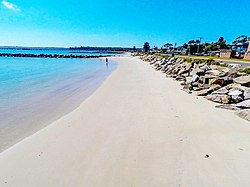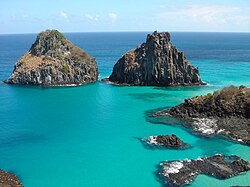
A groyne (in the U.S. groin) is a rigid aquatic structure built perpendicularly from an ocean shore (in coastal engineering) or a river bank, interrupting water flow and limiting the movement of sediment. It is usually made out of wood, concrete, or stone. In the ocean, groynes create beaches, prevent beach erosion caused by longshore drift where this is the dominant process and facilitate beach nourishment. There is also often cross-shore movement which if longer than the groyne will limit its effectiveness. In a river, groynes slow down the process of erosion and prevent ice-jamming, which in turn aids navigation.
Contents
- Background
- Etymology
- History
- Mechanics
- Beach evolution and sedimentation accretion
- Groyne fields
- Terminal groyne syndrome
- Headland groyne / Headland breakwater
- Usage
- Coastal management
- River management
- Types
- By their planview shape
- By cross-section based on material used
- By permeability
- By whether they are submerged
- By their effect on stream flow
- Gallery
- See also
- References
- Notes
- External links
All of a groyne may be underwater, in which case it is a submerged groyne. They are often used in tandem with seawalls and other coastal engineering features. Groynes, however, may cause a shoreline to be perceived as unnatural. Groynes are generally straight but could be of various plan view shapes, permeable or impermeable, built from various materials such as wood, sand, stone rubble, or gabion, etc.



















